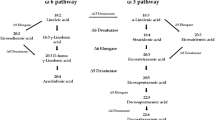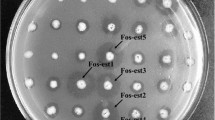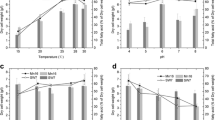Abstract
A marine bacterium, judged as a new species close toShewanella putrefaciens, was isolated from the intestinal contents of the Pacific mackerel. The isolated strain SCRC-2378 produced eicosapentaenoic acid (EPA) as the sole polyunsaturated fatty acid, which amounted to 24–40% of the total fatty acid in the cell, which corresponded to 2% of dry cell weight. Under the optimal growth conditions (pH 7.0, 20°C, and grown aerobically for 12–18 h), the yield of SCRC-2738 reached 15 g of dry cells/L or 2×1010 viable cells/mL. EPA existed as phospholipid and was found in thesn-2 position of phosphatidylethanolamine and phosphatidylglycerol. The 38 kbp (1,000 base pairs) genome DNA fragment was cloned from SCRC-2738 and expressed inEscherichia coli, which resulted in the production of EPA. The nucleotide sequence of the 38 kbp DNA fragment was determined. The DNA fragment contains eight open reading frames, and three of them posses homology with enzymes involved in fatty acid synthesis. Thus, it may be possible that these EPA biosynthesis genes are applied for EPA production in yeasts or higher plants, and offer a new method for EPA synthesis as new foods containing EPA.
Similar content being viewed by others
Abbreviations
- EPA:
-
eicosapentaenoic acid
- GLC:
-
gas-liquid chromatography
- kbp:
-
1,000 base pairs
- ORF:
-
open reading frame
- PE:
-
phosphatidylethanolamine
- pEPA:
-
the plasmid isolated from strain No. 95 of SCRC-2738
- PG:
-
phosphatidylglycerol
References
Murota, S., and I. Morita, Eicosapentaenoic Acid,IGAKUNOAYUMI 130, 787 (1987).
Murota, S., Prøstaglandins Leukotrienes, and Their Biological Significance,J. Japan Oil Chem. Soc. 30, 717–724 (1981).
Terano, T., A. Hirai, and Y. Tamura, Eicosapentaenoic Acid and Leukotriene,Metabolism 24, 229–240 (1987).
Harris, W.S., W.E. Conner, and M.P. McMurry, Reduction of Plasma Lipids and Lipoproteins by Dietary Omega-3 Fatty Acids,Amer. J. Clin. Nutr. 33, 928–931 (1980).
Sanders, T.A.B., M. Vickers, and A.P. Haines, Effect of Blood Lipids and Haemostasis of a Supplement of Cod-Liver Oil, Rich in Eicosapentaenoic and Docosahexaenoic Acids, in Healthy Young Men,Clin. Sci. 61, 317–324 (1981).
Singer, P., M. Wirth, S. Voigt, S. Zimontkowski, W. Goedicke, and H. Heine, Clinical Studies on Lipid and Blood Pressure Lowering Effect of Eicosapentaenoic Acid-Rich Diet,Biomed. Biochim. Acta 43 s421-s425 (1984).
von Rossonczy, T.O., A. Ruiter, H.C. Bronsgeest-Schoute, C.M. van Gent, and R.J.J. Hermus, The Effect of a Fish Diet on Serum Lipids in Healthy Human Subjects,Amer. J. Clin. Nutr. 31, 1340–1346 (1978).
Yazawa, K., K. Araki, N. Okazaki, K. Watanabe, C. Ishikawa, A. Inoue, N. Numao, and K. Kondo, Production of Eicosapentaenoic Acid by Marine Bacteria,J. Biochem. 103, 5–7 (1988).
Yazawa, K., K. Araki, K. Watanabe, C. Ichikawa, A. Inoue, K. Kondo, S. Watabe, and K. Hashimoto, Eicosapentaenoic Acid Productivity of the Bacteria Isolated from Fish Intestines,Nippon Suisan Gakkaishi 54, 1835–1838 (1988).
Yazawa, K., K. Watanabe, C. Ishikawa, K. Kondo, and S. Kimura, Production of Eicosapentaenoic Acid from Bacteria; Industrial Applications of Single Cell Oils, (D.J. Kyle, and C. Ratledge, eds.) American Oil Chemists' Society, Champaign, 1992, pp. 29–51.
Watanabe, K., C. Ichikawa, Y. Akahori, K. Yazawa, K. Kondo, and A. Kawaguchi, inProceedings of Japanese Conference on the Biochemistry of Lipids, conference held on July 23 in Kobe City, Hyogo, Japan, Vol. 31, Tokyo Print Co. Ltd., Tokyo, 1989, pp. 247–250.
Author information
Authors and Affiliations
About this article
Cite this article
Yazawa, K. Production of eicosapentaenoic acid from marine bacteria. Lipids 31, S297–S300 (1996). https://doi.org/10.1007/BF02637095
Issue Date:
DOI: https://doi.org/10.1007/BF02637095




